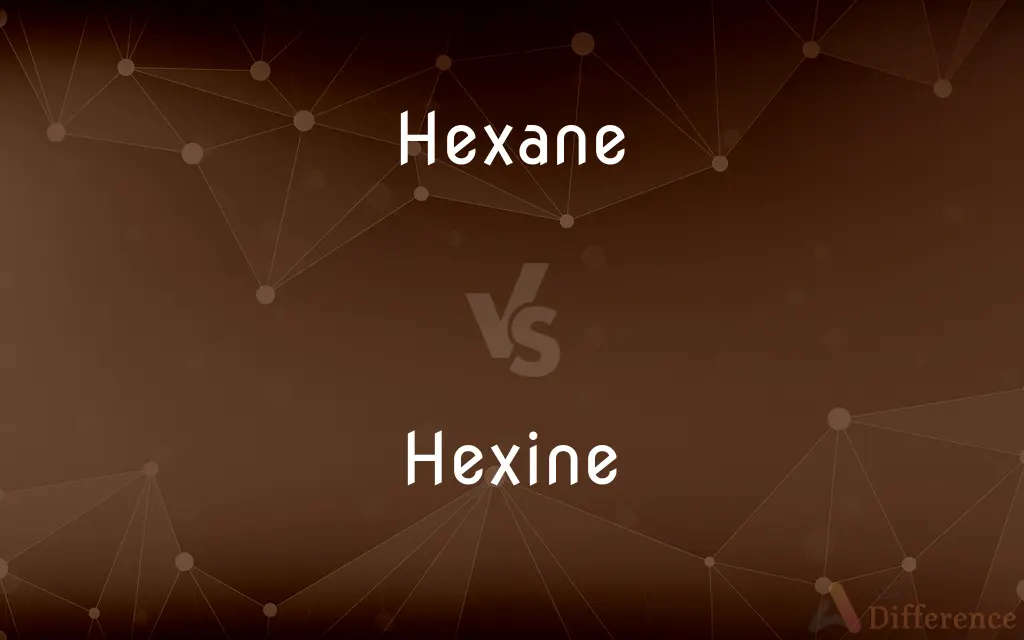Hexane vs. Hexine — What's the Difference?
By Maham Liaqat & Fiza Rafique — Updated on April 17, 2024
Hexane is a saturated hydrocarbon with a straight or branched chain and no double bonds, used primarily as a solvent; hexene (or hexine) refers to unsaturated hydrocarbons with at least one double bond, used in chemical synthesis and polymer production.

Difference Between Hexane and Hexine
Table of Contents
ADVERTISEMENT
Key Differences
Hexane consists of six carbon atoms connected by single bonds only, forming a fully saturated molecule. This makes it relatively non-reactive, which is why it is widely used as a non-polar solvent in industrial applications, such as the extraction of oils and fats from seeds. On the other hand, hexene (often called hexine) includes molecules that contain at least one double bond between carbon atoms, introducing unsaturation and making them more reactive and useful in chemical synthesis and the production of polymers.
Due to its saturated structure, hexane is less likely to undergo addition reactions, making it stable under normal conditions. Conversely, the presence of double bonds in hexene allows for addition reactions, which are critical in manufacturing plastics and other polymers.
Hexane is generally found as a colorless liquid with a slightly disagreeable odor, typical of alkanes, and is often used in laboratory settings as a solvent. Hexene, with its double bonds, is also a colorless liquid but has a distinctively sharper smell and is primarily utilized in the industrial synthesis of various products.
The production of hexane involves the refining of crude oil, where it is separated during the distillation process. Hexene, however, can be produced through various methods, including the catalytic cracking of alkanes and the dehydration of alcohols.
In terms of safety, both hexane and hexene pose health risks such as respiratory and skin irritation; however, hexane is particularly noted for its neurotoxic effects with prolonged exposure, which is a significant concern in industrial environments where ventilation may be poor.
ADVERTISEMENT
Comparison Chart
Bond Structure
Saturated (only single bonds)
Unsaturated (one or more double bonds)
Reactivity
Low reactivity
High reactivity (prone to addition reactions)
Common Uses
Solvent, especially in oil extraction
Production of polymers, chemical synthesis
Physical State
Colorless liquid, mild odor
Colorless liquid, sharp odor
Health Risks
Respiratory, skin irritation, neurotoxic
Respiratory, skin irritation
Compare with Definitions
Hexane
A component of gasoline, contributing to its volatility.
Hexane is blended into gasoline to improve its performance.
Hexine
An unsaturated hydrocarbon with double bonds, used in synthesizing other chemicals.
Hexene is a key monomer in the production of polyethylene.
Hexane
Known for its excellent solvent properties in the industrial sector.
The laboratory used hexane to clean grease from precision parts.
Hexine
Produced through methods like catalytic cracking.
Hexene production involves breaking down larger hydrocarbon molecules.
Hexane
Requires careful handling due to its volatility and health risks.
Proper ventilation is necessary when using hexane in industrial settings.
Hexine
Managed with precautions due to its flammability and reactivity.
Hexene storage requires stringent safety measures to prevent accidents.
Hexane
A saturated hydrocarbon with a formula of C6H14, used predominantly as a solvent.
Hexane is frequently used to extract edible oils from seeds and vegetables.
Hexine
Reactive due to its double bonds, making it useful in chemical reactions.
Hexene undergoes polymerization reactions to create plastic products.
Hexane
Extracts substances in food production without altering their properties.
Hexane was used to decaffeinate coffee and tea.
Hexine
Utilized in the manufacture of lubricants and additives.
Hexene contributes to the formulation of high-performance lubricants.
Hexane
Hexane () is an organic compound, a straight-chain alkane with six carbon atoms and has the molecular formula C6H14. Hexane is a significant constituent of gasoline.
Hexine
(organic compound) A hydrocarbon, C6H10, of the acetylene series; hexoylene.
Hexane
A colourless liquid hydrocarbon of the alkane series, present in petroleum spirit.
Hexine
A hydrocarbon, C6H10, of the acetylene series, obtained artificially as a colorless, volatile, pungent liquid; - called also hexoylene.
Hexane
Any of several isomeric colorless flammable liquid hydrocarbons, C6H14, derived from the fractional distillation of petroleum and used as a solvent and as a working fluid in low-temperature thermometers.
Hexane
(organic compound) Any of five isomeric aliphatic hydrocarbons, C6H14. They are colorless, volatile liquids.
Hexane
Any one of five hydrocarbons, C6H14, of the paraffin series. They are colorless, volatile liquids, and are so called because the molecule has six carbon atoms.
Hexane
A colorless flammable liquid alkane derived from petroleum and used as a solvent
Common Curiosities
Can hexane be used in the production of plastics?
No, hexane is not typically used in plastic production due to its saturated structure.
How does hexene differ from hexane in terms of chemical reactivity?
Hexene is more chemically reactive due to its unsaturated nature with double bonds.
What are the environmental impacts of hexane and hexene?
Both can contribute to air and water pollution if not properly managed.
What makes hexene valuable in industrial synthesis?
Its ability to undergo addition reactions makes it valuable for synthesizing polymers and other chemicals.
How are hexane and hexene produced?
Hexane is produced by refining crude oil, while hexene can be made through catalytic cracking and other methods.
How does the presence of double bonds in hexene influence its uses?
The double bonds allow for reactions that are essential in creating complex chemicals and materials.
What is hexane commonly used for?
Hexane is commonly used as a solvent in industrial applications and laboratories.
Are both hexane and hexene hazardous?
Yes, both are hazardous and can cause respiratory and skin irritation, with hexane also being neurotoxic.
What precautions are necessary when handling hexene?
Due to its reactivity and flammability, strict safety measures and proper storage are crucial.
What is the main physical characteristic of hexane and hexene?
Both are colorless liquids; hexane has a mild odor, while hexene has a sharper odor.
Share Your Discovery

Previous Comparison
Croup vs. Pseudocroup
Next Comparison
Terribly vs. AwfullyAuthor Spotlight
Written by
Maham LiaqatCo-written by
Fiza RafiqueFiza Rafique is a skilled content writer at AskDifference.com, where she meticulously refines and enhances written pieces. Drawing from her vast editorial expertise, Fiza ensures clarity, accuracy, and precision in every article. Passionate about language, she continually seeks to elevate the quality of content for readers worldwide.














































